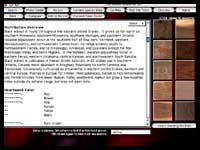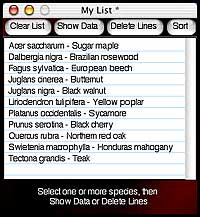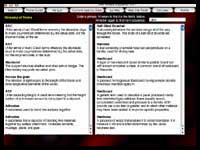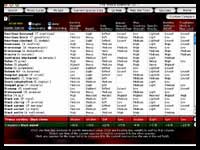

The Wood Explorer CD-ROM (part 2)
 Once you zero in on a particular wood, up pops
the main window with the species data on the left and scan thumbnails
on the right. In the data section, you can quickly scroll to
any sub-catagory by clicking the "Select" menu and
mousing to that particular item. The depth of information here
is impressive, followed by a very extensive bibliography of referenced
texts.
Once you zero in on a particular wood, up pops
the main window with the species data on the left and scan thumbnails
on the right. In the data section, you can quickly scroll to
any sub-catagory by clicking the "Select" menu and
mousing to that particular item. The depth of information here
is impressive, followed by a very extensive bibliography of referenced
texts.
Click on the image for a close-up view.
It's here that you can more easily understand how the publishers have normalized their data. Clicking the image at left you can see in the close-up an item labeled "Heartwood Color". Instead of simply telling you the color of American Black Walnut, (the species depicted here) they list all the different shades they found used to describe walnut preceded by a line-graph of asterisks. The more asterisks, the more often that color arose in their research.
I suspect they display their data this way to cover all bases. By including all the various opinions from every text they referenced, quantified by asterisks, they leave it to us to decide walnut's color. Along with the scans, that's pretty easy but I would like to see something better, at least for the more popular woods. And they carry this schema over to other characteristics of the wood. Here is what they say about walnut's texture:
Texture
*********+ Coarse
******** Fine
******** Medium
*** Coarse
* Uniform
* Medium coarse to coarse
* Fine
Does everyone understand this? Fortunately the button in the lower right labeled Understanding The Data opens a new window explaining their method for quantifying data. After reading it, I had to agree with their methodology even if I often found the results confusing. Most importantly, it's a way to display data for both species where there is a wealth of relevant information, and for species where information is widely scattered or simply contradictory.
 Clicking on the scan thumbnails opens
up a new window with a closeup of the wood. I liked this feature
the best in that you often find all the different shades one
might normally encounter when buying lumber. Much of the variability
is due to natural circumstances and I'm sure some is due to poor
color calibration in the scanning process. Even switching back
and forth between PC and Mac, there was variability in the depicted
wood samples. The PC images had their colors a bit over-saturated
and the Mac samples were often washed out. All in all, I preferred
the images as viewed on the Mac for being more realistic, but
tweaking the monitor settings on the PC corrected many of the
color problems here.
Clicking on the scan thumbnails opens
up a new window with a closeup of the wood. I liked this feature
the best in that you often find all the different shades one
might normally encounter when buying lumber. Much of the variability
is due to natural circumstances and I'm sure some is due to poor
color calibration in the scanning process. Even switching back
and forth between PC and Mac, there was variability in the depicted
wood samples. The PC images had their colors a bit over-saturated
and the Mac samples were often washed out. All in all, I preferred
the images as viewed on the Mac for being more realistic, but
tweaking the monitor settings on the PC corrected many of the
color problems here.
Click on the image for a close-up view.
Regardless, the scans are where this program shines, even if some of them aren't perfectly accurate. I can see taking along a laptop to an initial interview with clients and showing these scans as a way to narrow wood choices or stain colors. Having a common reference for a client to relate to is important, and dragging along numerous wood samples to every client meeting is a pain. I can see the woodworker who takes along The Wood Explorer getting jobs that others don't. Alas, the copy protection requires you to have the CD handy, and I can see forgetting that, as well.
 One of my favorite
features of The Wood Explorer is "My List"
which allows you to save search results in a list of favorite
woods. Adding a wood to My List is effortless - one click
- and from there you can quickly access those woods from anywhere
in the program. You don't want to type in search words for every
time you want to get scans of your favorite species of wood.
I liked My List!
One of my favorite
features of The Wood Explorer is "My List"
which allows you to save search results in a list of favorite
woods. Adding a wood to My List is effortless - one click
- and from there you can quickly access those woods from anywhere
in the program. You don't want to type in search words for every
time you want to get scans of your favorite species of wood.
I liked My List!
 Another feature I liked was the Glossary
(at right) where you can find definitions of many wood and woodworking
terms. Scrolling through the lists on both relatively ancient
computers was very fast, and the definitions are concise and
accurate.
Another feature I liked was the Glossary
(at right) where you can find definitions of many wood and woodworking
terms. Scrolling through the lists on both relatively ancient
computers was very fast, and the definitions are concise and
accurate.
On the down side, the Glossary window has a search box where you type in search terms and hit enter. I couldn't get it to work on either the PC or Mac. And for those who were hoping the Glossary would clear up the furniture beetles/powder post beetles controversy, it doesn't. Neither is listed, but you can find a decent definition of the word, "Hammer". :)
 The
last major features of The Wood Explorer involve comparing
wood properties between species. There are two methods here -
the standard comparison and the custom comparison. The Standard
Compare method, displayed on the left, takes a chosen wood
species and compares some of its properties to those of dozens
of other popular species. What you get is a spreadsheet of ratings
and the ability to sort the data in numerous ways.
The
last major features of The Wood Explorer involve comparing
wood properties between species. There are two methods here -
the standard comparison and the custom comparison. The Standard
Compare method, displayed on the left, takes a chosen wood
species and compares some of its properties to those of dozens
of other popular species. What you get is a spreadsheet of ratings
and the ability to sort the data in numerous ways.
Click on the image for a close-up view.
For the most part, the properties listed pertain to strength, stiffness, density, hardness and weight - all the criteria to appeal to structural engineers and dining table makers alike. You can access the standard comparison window from the main window after selecting a primary species. Unfortunately, you can't manually configure the broad range of species your chosen wood is compared to, so you have to sift through lots of listings for woods most Americans probably never heard of and likely won't ever use.
That's OK, to the rescue is the Custom Compare button. With a few clicks, you can compare dozens of wood properties among all the woods in My List. Ha Ha, finding this window put me in woodworker heaven - it's where the full potential of The Wood Explorer is realized. Just select two or more woods from My List, and select any of 45 different parameters, in two columns, to see how your favorites or potential favorites stack up to each other. This is where many beginning woodworkers may get in over their head, but seasoned veterans will find themselves muttering, "Yep, just as I suspected" or "You don't say!" What's more, where the data is sketchy, the authors wisely left the fields blank. I like that! It shows they aren't guessing and are taking a scientific approach to referencing the available data. Two thumbs up!
Conclusion
I had mixed feelings about The Wood Explorer. On the one
hand, the scans are a resource most woodworkers aren't going
to find anywhere else and poking around the rest of the program
is only going to make anyone smarter about wood. In my mind,
it's value as a reference to the active woodworker more than
justifies the cost.
On the other hand, I see many opportunities for improvement: the Color Guides need more guidence and the way species-specific data is displayed needs fewer asterisks and less ambiguity. Some of the scans are clearly over-saturated or under-saturated and believe it or not, they missed one of my favorite woods - the venerable Carpathian Elm Burl. I'd also like to see high-quality pictures of whole trees, bark and leaves similar to what you find in printed field guides. Thankfully, they plan to add these features.
Interface-wise, I would like to see them address navigation improvements within the program. As it is, The Wood Explorer spawns new windows far too often and if you accidently close the main window, there is no way to open a new one without re-launching the program. Keyboard shortcuts are skimpy, too. I would also dump the red/black window background in exchange for white - it's more neutral for viewing the wood scans. And how about more user customization? The ability for individuals to save changes to the data or add their own scans would be excellent!
Some of my concerns are addressed at their website where they swap out colored bar graphs for asterisks and discuss future enhancements to the program. Considering this is version 1.0, I think the authors have done a good job. The information is predominantly accurate and where it isn't (Cherry shapes better than walnut? I don't think so!), a little qualitative input from woodworkers is all that's needed. They realize this and have a web interface in place for such give and take.
I'd also like to see them partner with the Forest Products Laboratory, some exotic lumber wholesalers and perhaps a woodworking guild here and there to gather some contemporary input. The books from which they gleaned their data forms a strong basis for their first effort, but they can do better. I know it, they know it, and all that remains to be seen is if the woodworking public values The Wood Explorer enough to justify the continuing effort. I hope they do.
Jim Mattson
PS. I didn't have the opportunity to test The Wood Explorer on Windows XP. If any member of the WWA is using this OS and is willing to test the program and send me a short compatability review I can append to this review, let me know and I'll send you the CD. It will be yours to keep.